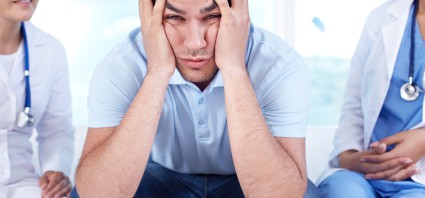Last Updated on January 30, 2020
June is Migraine and Headache Awareness Month. A vital part of awareness is knowing that migraines are much more than just a bad headache. Migraine is a neurological disease with incapacitating neurological symptoms that affects over 39 million men, women, and children in the United States. Most people who experience migraines get them once or twice a month, but more than 4 million are affected by daily chronic migraine with at least 15 days of debilitating symptoms every month.
 Everyone has headaches, but not everyone has migraines. Migraine involves nerve pathways, brain chemicals, and often runs in families but also has environmental factors. There are four stages of migraine: prodrome, aura, headache, and postdrome. It is possible to cycle through all the phases in an episode, or only experience one, two, or three of them. Each attack can vary from the ones before it.
Everyone has headaches, but not everyone has migraines. Migraine involves nerve pathways, brain chemicals, and often runs in families but also has environmental factors. There are four stages of migraine: prodrome, aura, headache, and postdrome. It is possible to cycle through all the phases in an episode, or only experience one, two, or three of them. Each attack can vary from the ones before it.
The prodrome is also known as “preheadache” and can last several hours or even days. Most people with migraine experience this phase but may not be aware at the time. The symptoms include irritability, depression, increased urination, food cravings, sensitivity to light or sound, difficulty concentrating or sleeping, yawning, fatigue and muscle weakness, and nausea. It is possible to take steps to lessen the severity or prevent altogether the oncoming headache by taking medication, minimizing/avoiding triggers, or biobehavioral techniques such as meditation or relaxation therapy.
Up to one-third of people with migraine experience an aura which presents with blurry vision, the appearance of geometric patterns, flashing or shimmering lights, blind spots in one or both eyes, or tunnel vision. Aura symptoms usually gradually appear over five minutes to an hour, and may serve as another warning of an impending headache. About 20% of migraine sufferers can have an aura last longer than 60 minutes, or occur with the headache instead of before.
The headache phase of a migraine attack is usually characterized by severe throbbing recurring pain on one side, though a third of attacks affect both sides of the head. A migraine headache can last from a few hours to several days. The severity of the headache can vary from person to person and episode to episode, with some causing only mild pain while others are truly incapacitating. Besides the pain, symptoms of the headache phase include nausea, inability to sleep, anxiety, and sensitivity to sound, light and smell. Any amount of physical activity can exacerbate the symptoms in this phase, making everyday activities difficult if not impossible.
The postdrome is also known as the “migraine hangover.” This final stage affects most people after the headache phase, though it may not follow every migraine attack and the length may vary. Symptoms of this phase include fatigue, body aches, trouble concentrating, dizziness, and sensitivity to light. Even though the headache is over, the postdrome can be equally as debilitating. People in the postdrome phase are still experiencing a migraine attack and can benefit from avoiding triggers and find some relief in relaxing activities, drinking water, and avoiding stress.
Every 10 seconds someone in the U.S. goes to the emergency room complaining of head pain, with acute migraine attacks being the cause of 1.2 million ER visits every year. Migraines affect 18% of women, 6% of men, and 10% of children. Before puberty, boys are affected more than girls, but during adolescence the risk of migraine and its severity rises in girls. Half of all migraine sufferers have their first attack before the age of 12. Migraine has even been reported in children as young as 18 months. Infant colic has even been found to be associated with childhood migraine and may even be an early form of migraine.
Healthcare and lost productivity costs associated with migraine are estimated to be as high as $36 billion annually in the United States. Healthcare costs are 70% higher for a family with a migraine sufferer than a non-migraine affected family; nearly 25% of U.S. households includes someone affected by migraine. Migraine sufferers, like those who suffer from other chronic illnesses, experience the high costs of medical services, too little support, and limited access to quality care. In 2018, there were about 500 certified headache specialists in the U.S. and 39 million sufferers. The vast majority of migraine sufferers do not seek medical care for their pain.
NeedyMeds has a database of over 17,000 free, low cost, or sliding scale clinics. Search your ZIP code for clinics in your area. Assistance for sufferers of chronic migraine and pain can be found in our Diagnosis-Based Assistance Database database. We also have a database of Patient Assistance Programs (PAPs) that provide prescription medications at low- or no cost. Search your medication (brand name or generic) and see if there are any programs available. Check our website at Needymeds.org for more resources or call our toll-free helpline at 1-800-503-6897, 9am to 5pm Eastern Time Monday through Friday.



